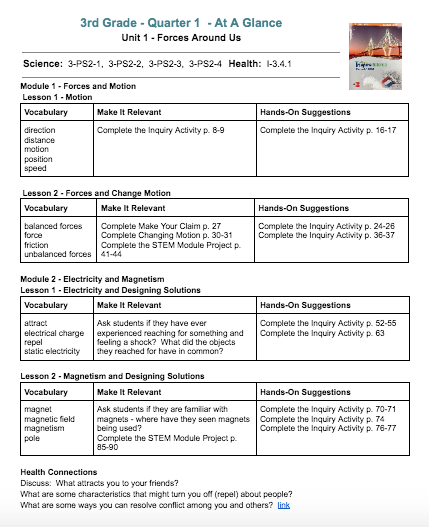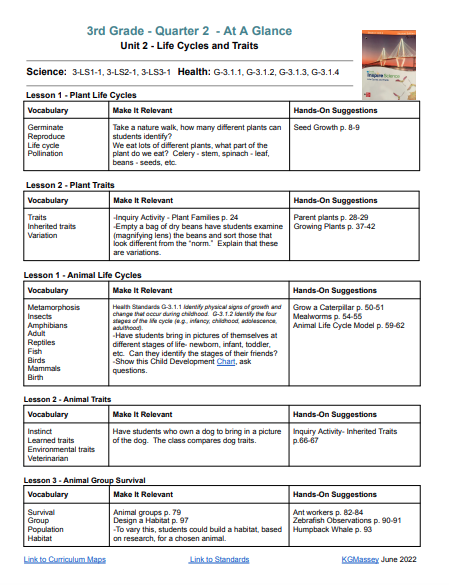Q1 At A Glance |
Q1 StandardsScience
3-PS2-1. Plan and conduct an investigation to provide evidence of the effects of balanced and unbalanced forces on the motion of an object. 3-PS2-2. Make observations and measurements of an object’s motion to provide evidence that a pattern can be used to predict future motion. 3-PS2-3. Ask questions to determine cause and effect relationships of electric interactions and magnetic interactions between two objects not in contact with each other. 3-PS2-4. *Develop possible solutions to a simple design problem by applying scientific ideas about magnets. Health I-3.4.1 Demonstrate nonviolent strategies to manage or resolve conflicts. |
Q2 At A Glance |
Q2 Standards |
Don't Forget to order your Butterfly Larvae, Zebrafish, and Mealworms
|
Science
3-LS1-1. Develop and use models to describe how organisms change in predictable patterns during their unique and diverse life cycles. 3-LS2-1. Construct an argument that some animals form groups that help members survive. 3-LS3-1. Analyze and interpret data to provide evidence that plants and animals have inherited traits that vary within group of similar organisms. Health G-3.1.1 Identify physical signs of growth and change that occur during childhood. G-3.1.2 Identify the four stages of the life cycle (e.g., infancy, childhood, adolescence, adulthood). |
Q3 At A Glance |
Q3 StandardsScience
3-LS3-2. Use evidence to support the explanation that traits can be influenced by the environment. 3-LS4-1. Analyze and interpret data from fossils to provide evidence of organisms and the environments in which they lived long ago. 3-LS4-2. Use evidence to construct an explanation for how the variations in traits among individuals of the same species may provide advantages in surviving and producing offspring. 3-LS4-3. Construct an argument with evidence that in a particular habitat some organisms can thrive, struggle to survive, or fail to survive. 3-LS4-4. Make a claim about the effectiveness of a solution to a problem caused when the environment changes and affects organisms living there. Health P-3.8.1 Discuss ways to help others be healthy. P-3.8.2 Describe ways to promote personal, school, community, and environmental health. |
Q4 At A Glance |
Q4 StandardsScience
3-ESS2-1. Represent data in tables and graphical displays of typical weather conditions during a particular season to identify patterns and make predictions. 3-ESS2-2. Obtain and combine information to describe climate patterns in different regions of the world. 3-ESS3-1. *Make a claim about the effectiveness of a design solution that reduces the impacts of a weather-related hazard. Health I-3.7.1 Explain safety rules at home, school and the community. I-3.7.2 Identify safety rules at school and the community. I-3.7.3 Describe safety rules in various environmental situations. I-3.7.4 Demonstrate appropriate responses to emergency situations, including basic first aid. |








